Multiple Choice Questions
Question 1. Which of the following fluoride solutions is unstable and has to be prepared freshly?
- APF gel
- SnF
- NaF
- SnF and NaF
Answer. 2. SnF
Question 2. The first dental hygienist was:
- Dr Alfred C Fones
- Mrs. Irene Newman
- John Green Wood
- Churchill
Answer. 1. Dr Alfred C Fones
Question 3. Which of the following is not a principle of primary health care?
- Intersectoral coordination
- Planning
- Community participation
- Equitable distribution
Answer. 2. Planning
Read And Learn More: Public Health Dentistry Question And Answers
Question 4. Which of the following is least cariogenic?
- Fructose
- Sorbitol
- Glucose
- Sucrose
Answer. 2. Sorbitol
Question 5. Pellagra results from deficiency of:
- Riboflavin
- Folate
- Pyridoxine
- Nicotinic acid
Answer. 4. Nicotinic acid
Question 6. In a slow sand filter, sand bed is cleaned by:
- Scraping
- Backwashing
- Digging
- Burning
Answer. 1. Scraping
Question 7. SD means:
- Dispersion around mean
- Root mean square deviation
- Sum total of all means
- Middle value
Answer. 1. Dispersion around mean
Question 8. Which study design is more suitable for rare cases with small number?
- Case control studies
- Cohort study
- Both of the above
- None of the above
Answer. 1. Case control studies
Question 9. Procedural steps in dental public health are:
- Analysis, operation, survey, finance, appraisal, planning
- Survey, planning, operation, finance, appraisal, analysis
- Survey, analysis, planning, operation, finance, appraisal
- Planning, survey, operation, finance, appraisal, analysis
Answer. 3. Survey, analysis, planning, operation, finance, appraisal
Question 10. Slogan of “A clean tooth never decay” was given by:
- Leon William
- GM Wright
- Alfred C. Fones
- GV Black
Answer. 1. Leon William
Question 11. Which of the following is the non-random type of sampling?
- Snow Ball
- Simple random
- Multiphase
- Systemic
Answer. 1. Snow Ball
Question 12. The study of disease frequency and distribution is called as:
- Standard deviation
- Variance
- Epidemiology
- Survey
Answer. 3. Epidemiology
Question 13. Which of the following is not the test of significance?
- t-test
- Z-test
- Square test
- ANOVA test
Answer. 4. ANOVA test
Question 14. For large country survey the sampling method of choice:
- Multiphase sampling
- Multiple sampling
- Cluster sampling
- Multistage sampling
Answer. 4. Multistage sampling
Question 15. Case control study is also called as:
- Retrospective study
- Prospective study
- Cross-sectional study
- None of the above
Answer. 1. Retrospective study
Question 16. Dentist Act came into action in:
- 1949
- 1948
- 1947
- 1950
Answer. 2. 1948
Question 17. Calibration is a procedure to assess:
- Intraexaminer variation
- Interexaminer variation
- Specificity of the study
- Both (a) and (b)
Answer. 4. Both (a) and (b)
Question 18. Relative risk is used in:
- Case control study
- Survey
- Cohort study
- Cross-sectional study
Answer. 3. Cohort study
Question 19. Index ages for the pathfinder survey are:
- 5, 15, 25, 35, 65
- 5, 10, 15, 30 and 60 to 70 years
- 5, 12, 15, 35 to 44 and 65 to 74 years
- 5 to 10, 15, 35 to 45 and 65 to 75 years
Answer. 3. 5, 12, 15, 35 to 44 and 65 to 74 years
Question 20. Normal curve resembles:
- Bell-shaped
- Sigmoid-shaped
- V-shaped
- None of the above
Answer. 1. Bell-shaped
Question 21. Method of choice when suitable land is not available for disposal is:
- Dumping
- Controlled tipping
- Incineration
- Composting
Answer. 3. Incineration
Question 22. What type of fluoride is most commonly found in toothpaste?
- Stannous fluoride and potassium chloride
- Strontium chloride and potassium fluoride
- Sodium monofluorophosphate and sodium fluoride
- Potassium fluoride and sodium fluoride
Answer. 3. Sodium monofluorophosphate and sodium fluoride
Question 23. Which of the following is correct statement?
- Delta dental plan was given in 1989
- Medicine was given in 1966
- Both of the above
- Delta dental plan was given in 1966
Answer. 4. Delta dental plan was given in 1966
Question 24. USA launched first water fluoridation in Grand Rapids in:
- 1925
- 1945
- 1943
- 1954
Answer. 2. 1945
Question 25. Father of Indian Dentistry:
- Dr R Ahmed
- Dr KL Shourie
- Dr Falis Mehta
- Dr Anil Kohli
Answer. 1. Dr R Ahmed
Question 26. EFDA is:
- Expended function dental auxilliaries
- Extra funding dental appliances
- Expanded forensic dentistry application
- None of the above
Answer. 1. Expended function dental auxilliaries
Question 27. High school children were taught regarding preventive oral health behavior by elementary school children:
- Theta program
- Tattle tooth program
- Learning about your oral health
- Tooth keeper program
Answer. 1. Theta program
Question 28. The waste stored in a red bag can be treated through:
- Autoclaving
- Microwaving
- Chemical treatment
- All
Answer. 1. Autoclaving
Question 29. Endemic disease means that a disease:
- Occurs clearly in excess of normal expectancy
- Is constantly present in a given population
- Exhibits seasonal pattern
- Is prevalent among animals
Answer. 2. Is constantly present in a given population
Question 30. To test the hypothesis regarding the causation of a disease in an epidemiological investigation undertaken is called:
- Case control study
- Cohort study
- Retrospective study
- None
Answer. 1. Case control study
Question 31. India’s Dentist Act was passed in:
- 1949
- 1947
- 1948
- 1950
Answer. 3. 1948
Question 32. Among the given observation, if any observation repeats maximum number of time it is known as:
- Median
- Mean
- Mode
- None
Answer. 3. Mode
Question 33. Which of the following can have more than one value?
- Mean
- Range
- Mode
- Median
Answer. 3. Mode
Question 34. The difference between the maximum and minimum observation is known as:
- Range
- Mode
- Quarentile deviation
- Standard deviation
Answer. 1. Range
Question 35. Bias due to different rates of admission to hospitals:
- Berkensonian
- Confounding
- Information
- Selection
Answer. 1. Berkensonian
Question 36. The shape of normal curve is:
- U-shaped
- V-shaped
- Bell shaped
- Dumbell shaped
Answer. 3. Bell shaped
Question 37. Census is conducted every:
- 2 years
- 5 years
- 7 years
- 10 years
Answer. 2. 5 years
Question 38. Heart of randomized control trial:
- Protocol
- Randomization
- Follow up
- Assessment
Answer. 2. Randomization
Question 39. Minimum number of professors in dental faculty in dental colleges with 60 admissions:
- 4
- 5
- 6
- 9
Answer. 3. 6
Question 40. How many registers are named in DCI?
- A and B
- A
- B
- Many
Answer. 1. A and B
Question 41. Descriptive epidemiology is also known as:
- Experimental study
- Observational study
- Analytical study
- Interventional study
Answer. 3. Analytical study
Question 42. Brudevold’s solution is also known as:
- Sodium fluoride
- Stannous fluoride
- Acidulated phosphate fluoride
- Amine fluoride
Answer. 3. Acidulated phosphate fluoride
Question 43. Nalgonda technique is used for:
- Fluoridation
- Defluoridation
- Both
- None of above
Answer. 4. None of above
Question 44. School Dental Nurse is a type of dental auxiliary:
- Nonoperating auxiliary
- Operating auxiliary
- Medical auxiliary
- None of above
Answer. 2. Operating auxiliary
Question 45. Who discovered periodontal disease index?
- Green and vermillion
- Loe and silness
- Ramfjord
- Silness and loe
Answer. 3. Ramfjord
Question 46. Who introduced Tell Show Do?
- John Show
- William Jack R
- Addlestone
- Mac Mohan
Answer. 3. Addlestone
Question 47. Drinking water is:
- Hard water
- Soft water
- Moderately hard water
- Distilled water
Answer. 2. Soft water
Question 48. First step of planning process is:
- Evaluate
- Identifying constraint
- Identifying the problem
- Determine Priorities
Answer. 3. Identifying the problem
Question 49. The headquarter of UNICEF is situated in:
- Los Angles
- Washington DC.
- New York
- Las Vegas
Answer. 3. New York
Question 50. Dental Council of India was formed:
- April 17,1948
- April 12, 1949
- August 10, 1942
- July 18, 1950
Answer. 2. April 12, 1949
Question 51. The functions of statistics are:
- Collection of data
- Presentation of data
- Analysis and interpretation of data
- All of the above
Answer. 4. All of the above
Question 52. Statistical results are:
- Absolutely correct
- Not true
- True on average
- Universally true
Answer. 3. True on average
Question 53. Charts and graphs facilitate:
- Comparison of values
- To know the trend
- To know the relationship
- All of the above
Answer. 4. All of the above
Question 54. Which diagram is used to represent quantitative data?
- Bar diagram
- Pie chart
- Histogram
- Multiple bar diagram
Answer. 3. Histogram
Question 55. To represent two or more factors simultaneously the following diagram is used:
- Bar diagram
- Histogram
- Pie chart
- Multiple bar diagram
Answer. 4. Multiple bar diagram
Question 56. Compilation of data means:
- Grouping of similar data
- Collection of data
- Presentation of data
- Tabulation of data
Answer. 1. Grouping of similar data
Question 57. Median is a measure of:
- Average
- Variation
- Correlation
- All of the above
Answer. 1. Average
Question 58. Following are the measures of central tendency except:
- Mean
- Median
- Mode
- Standard deviation
Answer. 4. Standard deviation
Question 59. Sum of observations by number of observations is known as:
- Arithmetic mean
- Geometric mean
- Harmonic mean
- Absolute mean
Answer. 1. Arithmetic mean
Question 60. Among the given observations if any observations repeat maximum number of time is known as:
- Median
- Arithmetic mean
- Mode
- None of the above
Answer. 3. Mode
Question 61. Proponents of plaque index are:
- Loe and Silness
- Silness and Loe
- Silness
- Loe
Answer. 2. Silness and Loe
Question 62. What type is oral hygiene index?
- Simple index
- Simplified index
- Irreversible index
- Reversible index
Answer. 2. Simplified index
Question 63. Measures of central tendency refer to:
- Standard deviation
- Frequency
- Mean, median, mode
- Frequency interval
Answer. 3. Mean, median, mode
Question 64. Name of the present President of Dental Council of India is:
- Dr Anil kohli
- Dr RK Bali
- Dr D Majumdar
- Pranav Mukherjee
Answer. 3. Dr D Majumdar
Question 65. First Community Water Fluoridation Programme was carried out in:
- 1942
- 1945
- 1955
- 1952
Answer. 2. 1945
Question 66. APF gel is applied in concentration of:
- 1:32
- 1:23
- 1:42
- 1:24
Answer. 2. 1:23
Question 67. Primary prevention refers to:
- Early diagnosis and prompt treatment
- Health promotion and specific protection
- Rehabilitation and disability
- All of the above
Answer. 2. Health promotion and specific protection
Question 68. First bone is to be found in the body:
- Mandible
- Maxilla
- Clavicle
- Hyoid
Answer. 3. Clavicle
Question 69. Tattle tooth programme was developed in:
- 1972-1974
- 1974-1976
- 1976-1978
- 1978-1980
Answer. 2. 1974-1976
Question 70. Chlorhexidine has the activity of:
- Antiplaque action
- Antibacterial action
- Both a and b
- None of the above
Answer. 3. Both a and b
Question 71. The data obtained directly from the individual is called as:
- Primary data
- Secondary data
- Tertiary data
- Quaternary data
Answer. 1. Primary data
Question 72. The data obtained from other outside sources is called as:
- Primary data
- Secondary data
- Tertiary data
- Quaternary data
Answer. 2. Secondary data
Question 73. A major disadvantage of private clinic is:
- There is no quality control
- Record keeping is not simple
- Poor people cannot afford it
- Very much time is wasted in formalities and waiting
Answer. 3. Poor people cannot afford it
Question 74. Where and when the first dental institution of India to teach dentistry on modern lines was started?
- Mumbai in the year 1931
- Kolkata in the year 1920
- Delhi in the year 1940
- Chennai in the year 1911
Answer. 2. Kolkata in the year 1920
Question 75. Dental institution is an organization established for:
- Dental health education
- Social cultural or charitable objectives
- Disabled people
- None of the above
Answer. 1. Dental health education
Question 76. Dental health education is concerned with:
- Treatment of dental diseases
- Prevention of dental diseases
- Interception of dental diseases
- Prevention and interception of dental diseases
Answer. 2. Prevention of dental diseases
Question 77. Which of the following is not an input unit?
- Keyboard
- Mouse
- CPU
- Disk drive
Answer. 3. CPU
Question 78. IDA is affiliated to:
- Asian Pacific Dental Federation
- WHO
- Pan American Health Organization
- National Institute of Dental Research
Answer. 1. Asian Pacific Dental Federation
Question 79. IDA was founded in:
- 1925
- 1935
- 1945
- 1955
Answer. 3. 1945
Question 80. The Dental Amendment Act was commenced in the year:
- 1989
- 1990
- 1991
- 1993
Answer. 4. 1993
Question 81. Weight of CPITN probe:
- 5 g
- 10 g
- 20 g
- 7 g
Answer. 1. 5 g
Question 82. Dentists Act was introduced on:
- 12th Apr 1949
- 7th Apr 1948
- 29th Mar 1948
- 26th Jan 1950
Answer. 3. 29th Mar 1948
Question 83. Father of epidemiology:
- Hippocrates
- John Snow
- John Last
- Claudius Galen
Answer. 2. John Snow
Question 84. First artificial water fluoridation plant was put up in:
- London
- Grand Rapids
- Colorado
- New York
Answer. 2. Grand Rapids
Question 85. A hypothesis is:
- A report
- A synopsis
- A theory
- A supposition from an observation
Answer. 4. A supposition from an observation
Question 86. ART was pioneered in:
- Zimbabwe
- Thailand
- Tanzania
- South Africa
Answer. 3. Tanzania
Question 87. Second generation pit and fissure sealants are:
- Chemically cured
- Visible light cured
- UV light cured
- All of the above
Answer. 1. Chemically cured
Question 88. Milk fluoridation was introduced by:
- Wespi
- Zeigler
- Dean
- Mckay
Answer. 2. Zeigler
Question 89. Tattle tooth program was conducted in:
- Texas
- North Carolina
- Toronto
- New York
Answer. 1. Texas
Question 90. WHO headquarters is situated in:
- London
- Geneva
- Mumbai
- Rome
Answer. 2. Geneva
Question 91. Normal curve is also known as:
- Stephen’s curve
- Gaussian curve
- Sigmoid curve
- Community curve
Answer. 2. Gaussian curve
Question 92. Standard deviation is a measure of:
- Correlation
- Statistical significance
- Central tendency
- Variation
Answer. 3. Central tendency
Question 93. Which of the following is a parametric test?
- Chi-square test
- t-test
- Mann Whitney test
- Kruskal Wallis Test
Answer. 2. t-test
Question 94. The hypothesis, which asserts that there is no real difference in the sample is:
- Alternative hypothesis
- Null hypothesis
- All or none law
- Situational hypothesis
Answer. 2. Null hypothesis
Question 95. Histogram is a:
- Pie diagram
- Bar diagram
- Frequency polygon
- Line diagram
Answer. 2. Bar diagram
Question 96. The most commonly employed sampling technique in national pathfinder survey is:
- Snowball sampling
- Convenience sampling
- Quota sampling
- Stratified cluster sampling
Answer. 4. Stratified cluster sampling
Question 97. Middle value of a series of given data arranged in an ascending or descending order is called:
- Median
- Mode
- Mean
- Average
Answer. 1. Median
Question 98. The key feature of randomized control trial is:
- Matching
- Randomization
- None of these
- Both of these
Answer. 2. Randomization
Question 99. Recruiting study participants through social network represents which sampling technique?
- Simple random sampling
- Stratified cluster sampling
- Systematic random sampling
- Snowball sampling
Answer. 4. Snowball sampling
Question 100. Which among these is non-probability sampling technique?
- Snowball sampling
- Convenience sampling
- Quota sampling
- All of the above
Answer. 4. All of the above
Question 101. OHI – S was developed by:
- Greene and Vermilion
- Russell AL
- Silness and Loe
- Trendley Dean
Answer. 1. Greene and Vermilion
Question 102. Dentist’s day is celebrated on:
- 8th March
- 6th March
- 31st May
- 7th Apr
Answer. 2. 6th March
Question 103. First known epidemiologist:
- Hippocrates
- John M Last
- John Snow
- Thomas Syndenham
Answer. 3. John Snow
Question 104. APF was introduced by:
- Knutson
- Brudevold
- Dean
- McKay
Answer. 2. Brudevold
Question 105. A decision about a course of action is:
- Goal
- Aim
- Objective
- Plan
Answer. 1. Goal
Question 106. Incidence of a disease can be known by:
- Longitudinal study
- Pilot study
- Cross – sectional study
- Retrospective study
Answer. 1. Longitudinal study
Question 107. First dental college in India was started in the city of:
- Mumbai
- Delhi
- Chennai
- Kolkata
Answer. 4. Kolkata
Question 108. Schmutzdecke is:
- Vital layer
- Zoogleal layer
- Biological layer
- All of the above
Answer. 3. Biological layer
Question 109. WHO’s global school health initiative was launched on:
- 1995
- 2000
- 2014
- 1980
Answer. 1. 2000
Question 110. Relationship between prevalence and incidence:
- P = l × D
- l = P × D
- P = l/D
- P=D/l
Answer. 1. P = l × D
Question 111. Normal curve is also known as:
- Stephen’s curve
- Gaussian curve
- Sigmoid curve
- Community curve
Answer. 2. Gaussian curve
Question 112. Standard deviation is a measure of:
- Correlation
- Statistical significance
- Central tendency
- Variation
Answer. 4. Variation
Question 113. Which of the following is a parametric test?
- Chi – Square test
- T – test
- Mann Whitney test
- Kruskal Wallis test
Answer. 2. T – test
Question 114. The hypothesis which asserts that there is no real difference in the sample is:
- Alternative hypothesis
- Null hypothesis
- All or None law
- Situational hypothesis
Answer. 2. Null hypothesis
Question 115. Histogram is a:
- Pie diagram
- Bar diagram
- Frequency polygon
- Line diagram
Answer. 2. Bar diagram
Question 116. The most commonly employed sampling technique in national pathfinder survey is:
- Snowball sampling
- Convenience sampling
- Quota sampling
- Stratified cluster sampling
Answer. 4. Stratified cluster sampling
Question 117. Middle value of a series of a given data arranged in an ascending or descending order is called:
- Median
- Mode
- Mean
- Average
Answer. 1. Median
Question 118. The key feature of randomized controlled trial is:
- Matching
- Randomization
- None of these
- Both of these
Answer. 2. Randomization
Question 119. Recruiting study participants through social network represents which sampling technique?
- Simple random sampling
- Stratified cluster sampling
- Systemic random sampling
- Snowball sampling
Answer. 4. Snowball sampling
Question 120. Which among these is nonprobability sampling technique?
- Snowball sampling
- Convenience sampling
- Quota sampling
- All the above
Answer. 4. All the above
Question 121. Correlation between two variables is depicted by:
- Bar diagram
- Line diagram
- Histogram
- Scatter diagram
Answer. 4. Scatter diagram
Question 122. Prevalence of disease affects:
- Sensitivity
- Specificity
- Predictive value
- Repeatability
Answer. 3. Predictive value
Question 123. In 3 × 3 table, the number of degrees of freedom is:
- 3
- 9
- 4
- 81
Answer. 3. 4
Question 124. Vipeholm study is indicated in:
- AIDS
- Dental caries
- Oral cancer
- Periodontal disease
Answer. 2. Dental caries
Question 125. Another name of case control study is:
- Retrospective
- Prospective
- Prevalence
- Incidence
Answer. 1. Retrospective
Question 126. Which type of bias is eliminated by blinding?
- Berksonian
- Recall
- Confounding
- Interviewers
Answer. 4. Interviewers
Question 127. Example for the specific protection is:
- Immunization
- Health education
- Potable water
- Decayed tooth restoration
Answer. 1. Immunization
Question 128. In which of the phase randomized control trials are conducted?
- Phase 1
- Phase 2
- Phase 3
- Phase 4
Answer. 3. Phase 3
Question 129. Another name of periodontal index is:
- Loe and Sillness Index
- Russell index
- Romford index
- Schick and Ash index
Answer. 2. Russell index
Question 130. What does CPITN stands for?
- Community periodontal index with treatment needs
- Community periodontal index for treatment needs
- Community periodontal index of treatment needs
- Community periodontal index and treatment needs
Answer. 3. Community periodontal index of treatment needs
Question 131. Name the DMF teeth:
- 28
- 30
- 26
- 32
Answer. 4. 32
Question 132. Duraphat is:
- Fluoride varnish
- Stannous fluoride
- GIC
- Lacquer
Answer. 1. Fluoride varnish
Question 133. In which region tooth fluoride is least effective?
- Cusp
- Buccal area
- Palatal area
- Pit and Fissure area
Answer. 4. Pit and Fissure area
Question 134. India aim to eliminate which disease by 2015?
- Malaria
- Filariasis
- Kala azar
- Tuberculosis
Answer. 2. Filariasis
Question 135. How much population is covered by the subcenter?
- 1000 population
- 2000 population
- 3000 population
- 5000 population
Answer. 4. 5000 population
Question 136. As tooth is extracted, it should be discarded in which bag?
- Red
- Black
- Yellow
- Blue
Answer. 1. Red
Question 137. Recognized behavior in society is known as:
- Custom
- Tradition
- Culture
- Folkways
Answer. 4. Folkways
Question 138. Reverse smoking is most commonly practiced in which State of India?
- Madhya Pradesh
- Uttar Pradesh
- Arunachal Pradesh
- Andhra Pradesh
Answer. 4. Andhra Pradesh
Question 139. New cross auxiliaries are:
- Dental nurse in India
- Dental nurse in Australia
- Dental nurse in Britain
- Dental nurse in USA
Answer. 3. Dental nurse in Britain
Question 140. Waste water from kitchen:
- Kitchen water
- Garbage
- Sewage
- Sullage
Answer. 4. Sullage
Question 141. Chemical used for disinfection of water is:
- Bleaching powder
- Potassium chloride
- Sodium chloride
- Calcium chloride
Answer. 1. Bleaching powder
Question 142. The percentage of APF gel used for topical application:
- 1.23%
- 2%
- 10%
- 8%
Answer. 1. 1.23%
Question 143. One of the following age is chosen as the global monitoring age for the caries for international comparison and monitoring of disease trends:
- 5 years
- 12 years
- 15 years
- 40 years
Answer. 2. 12 years
Question 144. In simplified oral hygiene index, how many surfaces of the teeth are examined:
- 6
- 12
- 18
- 24
Answer. 1. 6
Question 145. “World health day” is celebrated on:
- 1st April
- 11th June
- 7th April
- 8th March
Answer. 3. 7th April
Question 146. A sample in which every element in the population has an equal and independent chance of being selected is termed as:
- Simple random sample
- Judgment sample
- Convenient sample
- Snow ball sample
Answer. 1. Simple random sample
Question 147. The term incidence refers to the:
- Rate of disease
- Number of new cases of disease
- Proportion of population affected by the disease
- Number of old and new cases of disease
Answer. 2. Number of new cases of disease
Question 148. One of the following is not a pit and fissure sealant:
- Polyurethane
- Cyanoacrylates
- Bis-GMA
- Merbromin
Answer. 4. Merbromin
Question 149. Treating dental defects as they occur and not waiting until needs build up is called:
- Comprehensive dental care
- Incremental dental care
- Essential care
- Initial care
Answer. 2. Incremental dental care
Question 150. Least cariogenic sugar is:
- Fructose
- Glucose
- Sucrose
- Xylitol
Answer. 4. Xylitol
Question 151. When a series of lectures are delivered on a single subject of focus it is called as:
- Symposium
- Panel discussion
- Workshop
- Conference
Answer. 1. Symposium
Question 152. Blinding is done to reduce:
- Confounding factor
- Bias
- Manipulation
- Risk
Answer. 2. Bias
Question 153. Which is not a part of epidemiologic triad:
- Host
- Environment
- Agent
- PHC
Answer. 4. PHC
Question 154. The method of application of neutral sodium fluoride is called as:
- Muhler’s technique
- Knutson’s technique
- Brudevold technique
- Englader technique
Answer. 2. Knutson’s technique
Question 155. The training of school dental nurse extends over the period of:
- Three years
- Two years
- Four years
- One year
Answer. 2. Two years
Question 156. Trench method is which type of waste disposal:
- Incineration
- Composting
- Sanitary landfill
- Burial
Answer. 3. Sanitary landfill
Question 157. Kappa value of 0.6–0.8 means:
- Total agreement
- Good agreement
- Substantial agreement
- Moderate agreement
Answer. 3. Substantial agreement
Question 158. The study which was done in mental institution is:
- Vipeholm study
- Hopewood house study
- Trista Da Cunha study
- Turku sugar study
Answer. 1. Vipeholm study
Question 159. Loe and Silness gingival index is a:
- Reversible index
- Irreversible index
- Disease index
- Treatment index
Answer. 1. Reversible index
Question 160. The consumer protection act came into force in the year:
- 1987
- 1994
- 1993
- 1997
Answer. 1. 1987
Question 161. Lottery method is a type of:
- Simple random sampling
- Stratified sampling
- Systematic sampling
- Cluster sampling
Answer. 1. Simple random sampling
Question 162. Normal distribution curve is also called as:
- Binominal
- Poisson
- Gaussian
- None
Answer. 3. Gaussian
Question 163. Prophylactic odontotomy by:
- Hyatt
- Miller
- Bodecker
- Wilson
Answer. 1. Hyatt
Question 164. Ergonomics means:
- Job related accidents
- Health related to occupation
- Fitting in job
- None
Answer. 3. Fitting in job
Question 165. Correct relationship between prevalence (p), incidence (I), duration (D):
- P = I × D
- D = P × I
- I = P × D
- P = I/D
Answer. 1. P = I × D
Question 166. The scoring for periodontal index for mild gingivitis is:
- 1
- 2
- 3
- 6
Answer. 1. 1
Question 167. Who identified Colorado stains:
- Dean
- Churchill
- G V Black
- Fredrick McKay
Answer. 4. Fredrick McKay
Question 168. First ADA approved fluoride toothpaste in year:
- 1960
- 1968
- 1964
- 1954
Answer. 3. 1964
Question 169. Vipeholm study is used in:
- Oral cancer
- Caries
- AIDS
- Periodontitis
Answer. 2. Caries
Question 170. Prevalence of a disease is:
- Rate
- Ratio
- Proportion
- Deviation
Answer. 2. Ratio
Fill In The Blanks
Question 1. Dr …………… is the president of dental council of India.
Answer. Dibyendu Mazumdar
Question 2. No Tobacco day is celebrated in the world on ……………
Answer. 31st May
Question 3. Cohort study is an example of …………… epidemology.
Answer. Observational
Question 4. The percentage of acidulated Phosphate Fluoride is…………… %
Answer. 1.23%
Question 5. Sodium fluoride is stored in …………… bottles.
Answer. Plastic
Question 6. Nalgonda technique of defluouridation was developed at …………… Maharastra.
Answer. NEERI, Nagpur
Question 7. …………… smoking is usually done in coastal areas of south India which results in oral cancer.
Answer. Reverse
Question 8. Name the regional headquarter located in India……………
Answer. Regional Office for South-east Asia (ROSA).
Question 9. Oral hygiene day is celebrated in India on ……………
Answer. 1 August
Question 10. Who is the father of dentistry in India ……………
Answer. Dr Rafiuddin Ahmad
Question 11. What is the name of first book in dentistry……………
Answer. Artzney Buchlein: wider allerlei kranckeyten und gebrechen dertzeen Or Zene Artzney.
Question 12. Experimental epidemiology study is also called as……………
Answer. Trial
Question 13. CPITN stands for……………
Answer. Community Periodontal Index of Treatment Needs
Question 14. First dental college in India……………
Answer. Dr R Ahmad Dental College and Hospital, Kolkata
Question 15. Space between two central incisor is called as……………
Answer. Midline Diastema
Question 16. Dentist Act was passed in the year……………
Answer. 1948
Question 17. APF gel used in the concentration of……………
Answer. 1:23
Question 18. Example of a composite index is……………
Answer. Russel’s periodontal Index
Question 19. Maximum score for the OHI-S……………
Answer. 6
Question 20. The value of critical plaque pH……………
Answer. 5.5
Question 21. UNICEF full form is……………
Answer. United Nations International Children Emergency Fund
Question 22. Full form of CPITN is……………
Answer. Community Periodontal Index for Treatment Needs
Question 23. Full form of AIDS is……………
Answer. Acquired Immunodeficiency Syndrome
Question 24. Full form of IDA is……………
Answer. Indian Dental Association
Question 25. An example for reversible type of index is……………
Answer. Gingival index
Question 26. Full form of COPRA is……………
Answer. Consumer Protection Act
Question 27. Full form of WHO is……………
Answer. World Health Organisation
Question 28. World oral health day is celebrated on……………
Answer. It was celebrated on 12th September, but from 2013 it is celebrated on 20th March after a decision in Hong Kong and subsequent publication of a revised policy statement
Question 29. Markings on William’s graduated probe is……………
Answer. 1-2-3-5-7-8-9-10
Question 30. Full form of OHI-S is……………
Answer. Oral hygiene Index- Simplified
Question 31. If a screening test is positive and the individual did have the disease, it is termed as……………
Answer. True positive
Question 32. The term …………… is used to indicate all current cases (old and new) existing in a given population at a given point in time or over a period of time.
Answer. Prevalence
Question 33. The property of an index to measure, what it is intended to measure is called……………
Answer. Validity
Question 34. …………… is a strong social prohibition against words, objects, actions or discussions considered undesirable by a community.
Answer. Taboo
Question 35. Middle value of a series of a given data arranged in ascending or descending order is called……………
Answer. Median
Question 36. Screening for oral cancer is …………… level of prevention.
Answer. Secondary
Question 37. A bicationic chemical plaque control agent having a “pin cushion effect” is……………
Answer. Chlorhexidine
Question 38. ”Consumer Protection Act” became a law in the year……………
Answer. 15th April 1987
Question 39. …………… is a microorganism commonly associated with root surface caries.
Answer. Actinomyces viscosus
Question 40. Black band on a CPI probe is between …………… to…………… mm.
Answer. 3.5 to 5.5
Question 41. Preventive measures taken before the initiation of the disease is known as…………… prevention.
Answer. Primary
Question 42. Dental council of India is located at……………
Answer. New Delhi
Question 43. When the pictures are drawn in the presentation of data, it is known as……………
Answer. Pictogram
Question 44. The dental auxiliary who does oral prophylaxis and is registered in Register – B in India is……………
Answer. Dental Hygienist
Question 45. Reverse smoking is practiced in coastal areas of……………Pradesh.
Answer. Andhra
Question 46. World health day is celebrated on……………
Answer. 7th April
Question 47. The head office of Indian Dental Association is at……………
Answer. Mumbai
Question 48. Nalgonda technique of defluoridation was developed at NEERI in the…………… city.
Answer. Nagpur
Question 49. Epidemiological triad consists of…………… host and environment.
Answer. Agent
Question 50. Dentist’s Act of India has…………… chapters.
Answer. Five
Question 51. ………………… is the difference between maximum and minimum values.
Answer. Range
Question 52. Extracted tooth should be disposed in ………………colored bags.
Answer. Red
Question 53. Father of Modern epidemiology is……………………….
Answer. Dr. John Snow
Question 54. Alma Ata conference was held in …………………..year.
Answer. 1978
Question 55. Ottawa charter is the basis for health……………..
Answer. Promotion
Question 56. In Turku sugar study there was a reversal of caries in…………….. groups.
Answer. Xylitol
Question 57. Salt fluoridation was started in the city of………………
Answer. Switzerland
Question 58. ………………..was first artificially fluoridated on 25th January 1995.
Answer. Grand Rapids, Michigan
Question 59. ART was started by……………………..
Answer. Prof. Jo Frencken (1996) in South Africa
Question 60. …………………..first did prophylactic odontomy.
Answer. Hyatt (1936)
Question 61. Father of epidemiology is…………………
Answer. John Snow
Question 62. World health day is celebrated on…………………….
Answer. 7th April
Question 63. An example of cumulative index is……………………
Answer. DMFT index for dental caries
Question 64. Milk fluoridation was introduced by……………….
Answer. Ziegler
Question 65. First dental college in India was established on ……………….
Answer. 1926
Question 66. ……………………… is the Father of dental hygiene.
Answer. Dr. Alfred Civilion Fones
Question 67. ………………….is the prevention of the emergence of risk factors in countries or population groups in which they have not yet appeared.
Answer. Primordial prevention
Question 68. In…………………type of communication the flow of information in one way from sender to receiver.
Answer. One way
Question 69. COPRA came into force on…………………….
Answer. 15th April 1987
Question 70. The ‘def’ index was described by………………..
Answer. Grubbel in 1944
Question 71. No tobacco day is observed on………………………… of every year.
Answer. 31st May
Question 72. Soon after brushing the tooth surface, a salivary mucoprotein that form is called as………………….
Answer. Acquired pellicle
Question 73. Pulpotomy and root canal therapy form ………………………level of prevention.
Answer. Tertiary
Question 74. 1ppm means……………………..g per kilogram.
Answer. 0.001
Question 75. ……………………..is commonly used as surfactant in a dentifrice.
Answer. Sodium lauryl sulphate
Question 76. Bromocresol green is used as an indicator in …………………..test.
Answer. Snyder
Question 77. …………………………is a classic 10 year study done on institutional children, fed on Spartan diet in Australia.
Answer. Hopewood House Study
Question 78. ……………………….is the process of destroying all microbes including their spores.
Answer. Sterilization
Question 79. The black band on a CPI probe is from……………. to ………………….mm.
Answer. 3.5 to 5.5
Question 80. ………………….is a microorganism commonly associated with root surface caries.
Answer. Actinomyces viscosus
Question 81. To compare the height of males and females………………..test will be used.
Answer. Student’s t test
Question 82. …………………….is the number of death of infants under one month of age per 1,000 live births.
Answer. Infant mortality rate
Question 83. The first dental college of India was established in year……………………
Answer. 1920
Question 84. Combination of CO and hemoglobin forms……………………
Answer. Carboxyhemoglobin
Question 85. Loudness of sound is measured in………………….
Answer. decibel (dB)
Question 86. IAPHD stands for………………….
Answer. Indian Association of Public Health Dentistry
Question 87. Kids toothpaste should have………….ppm of fluoride
Answer. 1000
Question 88. ………………….discovered fluorine
Answer. Henri Moissan
Question 89. Root caries index was given by…………………….
Answer. Ralph V Katz (1949)
Question 90. First water fluoridation was launched on date………………….
Answer. 25th January 1945
Question 91. GOBI campaign is promoted by…………………..
Answer. UNICEF
Question 92. Oral hygiene day is celebrated on……………………..
Answer. 1st August
Question 93. National environmental engineering research Institute (NEERI) is located at………………
Answer. Nagpur
Question 94. Global monitoring age for dental caries is…………………….
Answer. 12 years
Question 95. Expand THETA………………
Answer. Teenage health education teaching assistants program
Question 96. Specific protection is……………….level of protection.
Answer. Primary
Question 97. The property of ‘Pin cushion effect’ is exhibited by………………….
Answer. Chlorhexidine
Question 98. A sudden occurrence of an infectious disease in a community at a particular time is called……………..
Answer. Epidemic
Question 99. ‘Matching’ is the characteristic of………………………..type of epidemiological study.
Answer. Case control
Question 100. ART is………………………….
Answer. Atraumatic restorative technique
Question 101. Most commonly employed sampling technique in national pathfinder survey is………………..
Answer. Random
Question 102. Histogram is a……………….
Answer. Pictorial diagram of frequency distribution
Question 103. Disinfecting agent most commonly used in water purification on large scale is………….
Answer. Chlorine
Question 104. Ancient Indian medicine is based on which theory………………
Answer. Theory of Pancha bhootas (five element theory)
Question 105. Component of epidemiological triad are…………………
Answer. Agent, host and environment
Question 106. Certainly lethal dose (CLD) of fluoride is………………
Answer. 32 to 64 mg of fluoride/kg body weight
Question 107. Recommended index ages and age group for pathfinder surveys are……………….
Answer. 5, 12, 15, 35–44 and 65–74 years
Question 108. Fones method of brushing is indicated for…………………..
Answer. Young children, physically handicapped children, patients who lack dexterity
Question 109. The Father of dentistry in India is…………………..
Answer. Dr. Rafiuddin Ahmed
Answer In A Sentence Or A Word
Question 1. Name any two dental Varnishes.
Answer. Duraphat and Fluor protector
Question 2. What is pincushion effect?
Answer. The dicationic chlorhexidine molecule, attaches to the pellicle by one cation, to the bacteria attempting to colonize the tooth surface with the other. This is called as pincushion effect.
Question 3. What are ADA specifications of a toothbrush?
Answer. Following are the ADA specifications of a toothbrush:
- 1-1.25 inches in length
- 5/16 to 3/8 inches in width
- 2 to 4 rows of bristles
- 5-12 tufts/row
Question 4. What is the scientific name of Vitamin E?
Answer. Tocopherol
Question 5. Principles of primary health care.
Answer. Following are the principles:
- Equitable distribution
- Community participation
- Intersectoral coordination
- Appropriate technology
- Focus on prevention
Question 6. Name any two controlled water fluoridation studies.
Answer. Grand Rapids-Muskegon Study and NewburghKingston study
Question 7. Stephan’s curve
Answer. Stephan showed that within 2 to 4 minutes of rinsing with a solution of glucose, plaque pH is reduced from about 6.5 to 5 and gradually returns to the original value within approximately 40 minutes. This is graphically plotted as ‘Stephan’s Curve’.
Question 8. What is Bias in case controlled studies?
Answer. Bias is any systemic error in the determination of the association between the exposure and disease. The possibility of bias must be considered when evaluating a possible cause and effect relationship.
Question 9. When is the Anti-Tobacco day celebrated?
Answer. 31st May
Question 10. What is primordial prevention in public health?
Answer. It is the prevention of the emergence or development of risk factors in countries or population groups in which they have not yet appeared. The main intervention is by individual and mass education.
Additional Information
Various Tests of Significance
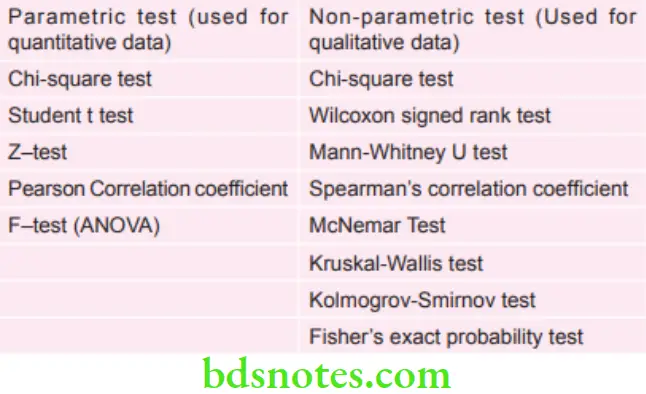
Various Terminologies in Epidemiology
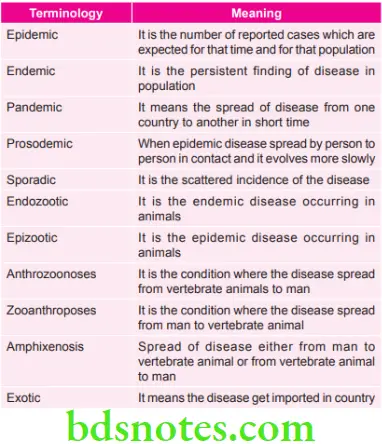
Rating System of Hierarchy of Evidence
Level 1: Systematic review or meta-analysis of all the relevant randomized controlled trials or evidence based clinical practice guidelines based on systematic reviews.
Level 2: At least one well designed randomized controlled trial.
Level 3: Well designed controlled trials without the randomization.
Level 4: Well designed case control or cohort study.
Level 5: Systematic review of descriptive and qualitative studies.
Level 6: A single descriptive or qualitative study.
Level 7: Opinion of authorities and/or reports of expert communities.
Various Indexes and Teeth Examined in Them
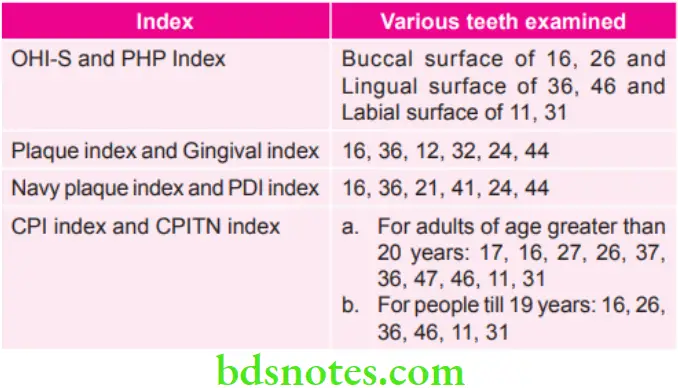
Various Types of Fluoridation Systems and Components Used in Them

Various Fluoridation Methods and their Reduction in Dental Caries
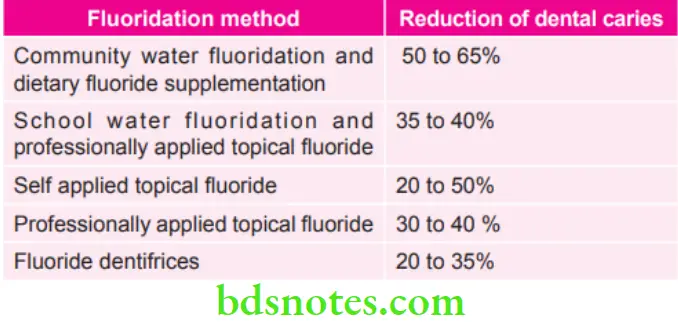
Levels of Fluoride and their Effects on Teeth
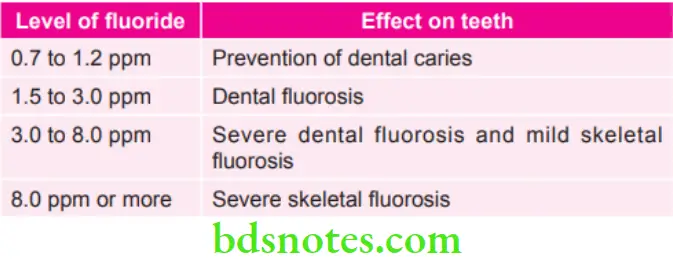
Doses of Fluoride
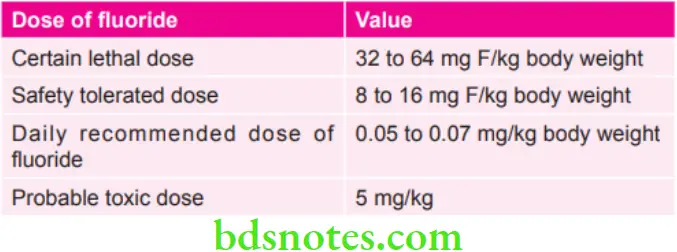
Normal Levels of Fluoride
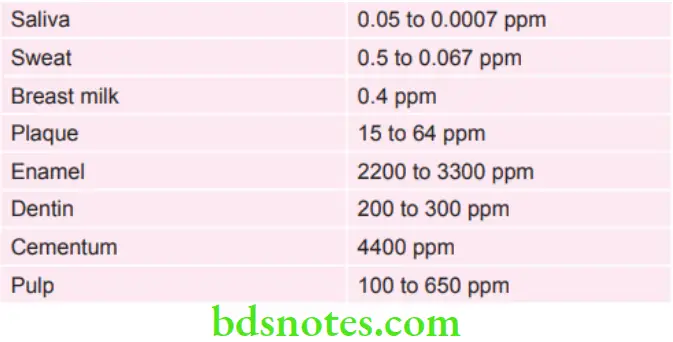
History of Community Water Fluoridation
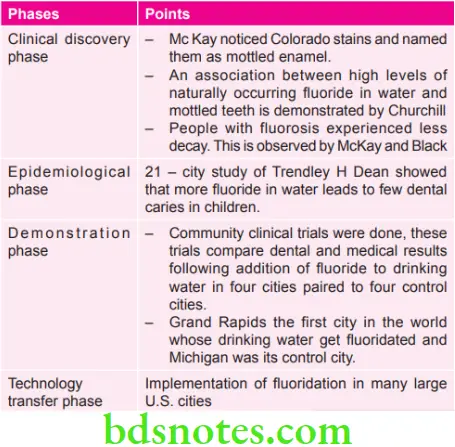
Various Countries with Percentage of Water Fluoridation
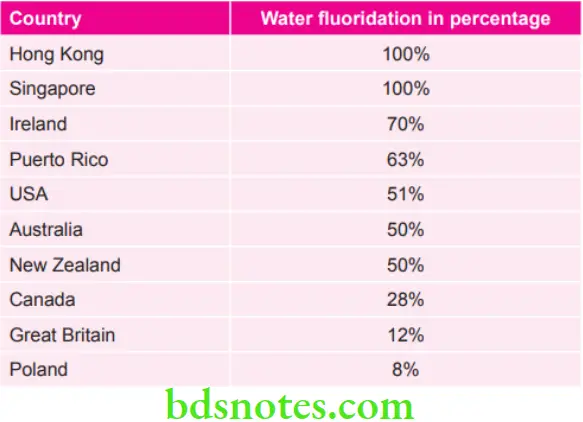
Various Cities Fluoridated Along with their Control Cities
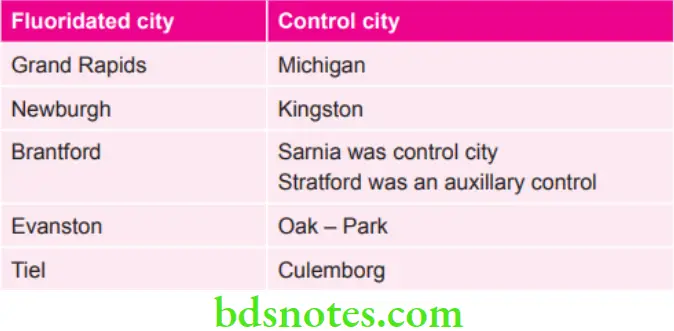
Various Dyes and their Use
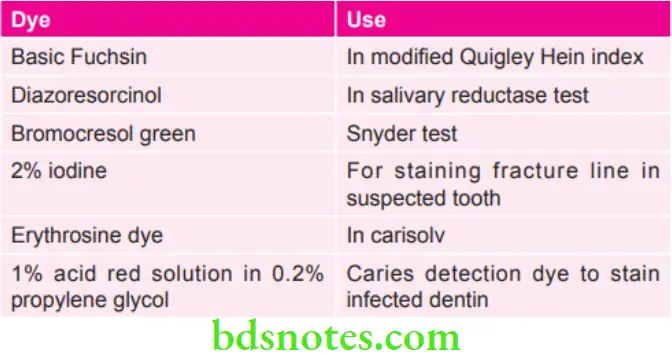
WHO Themes and their years
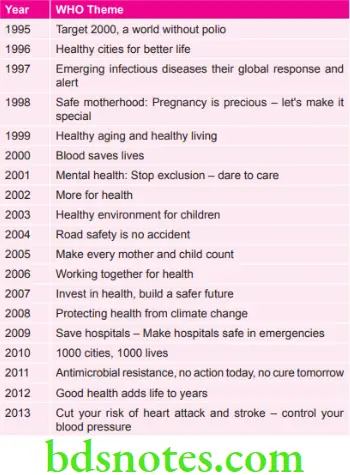
Various World Health Days of the Importance
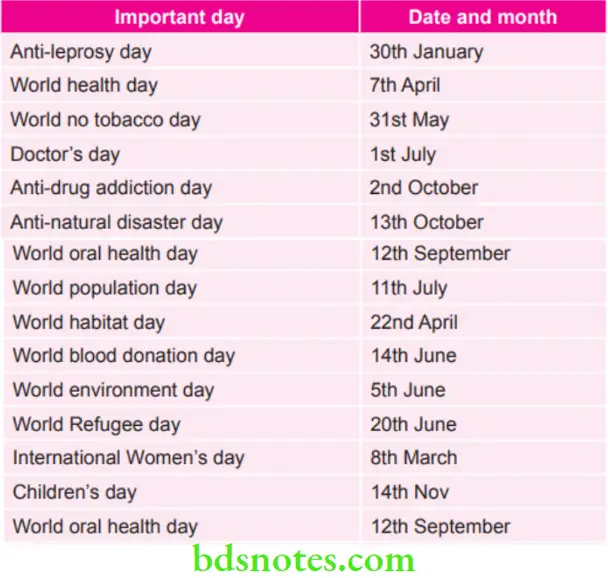
Various Categories of Biomedical Waste in India
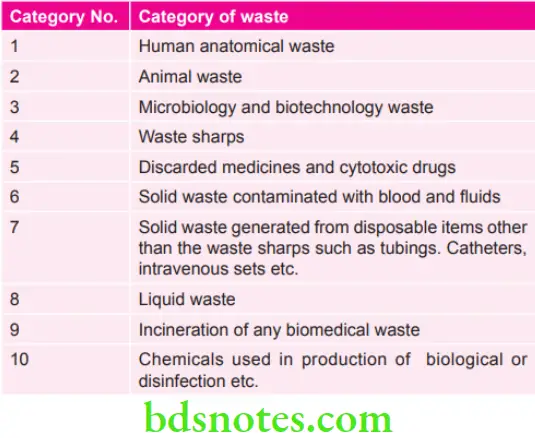
Color Coding and Various Containers used for Disposal of Biomedical Waste
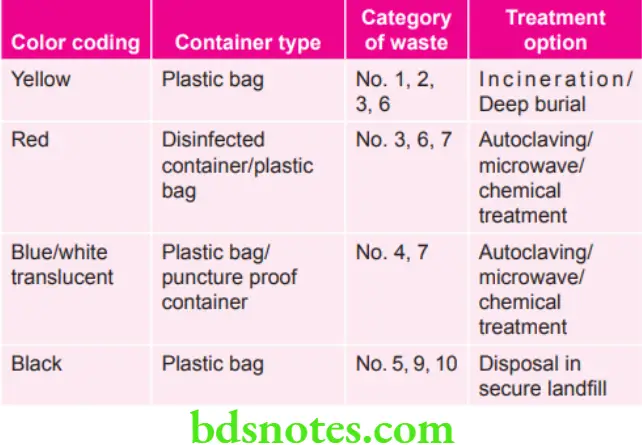
Miller’s Classification of Tooth Mobility
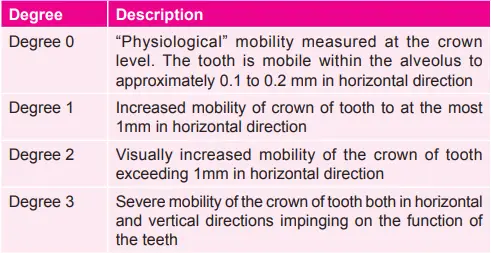
Types of Evaluation Along with their Description
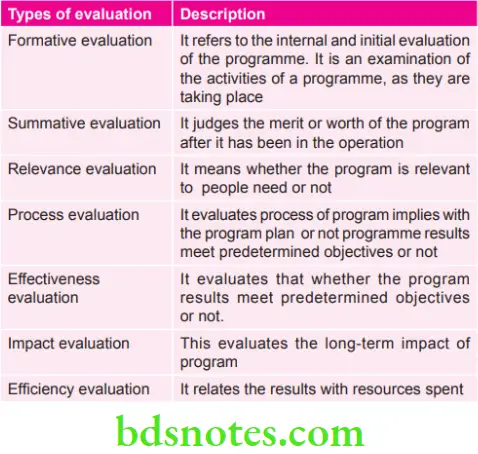
Various Carriers with their Examples
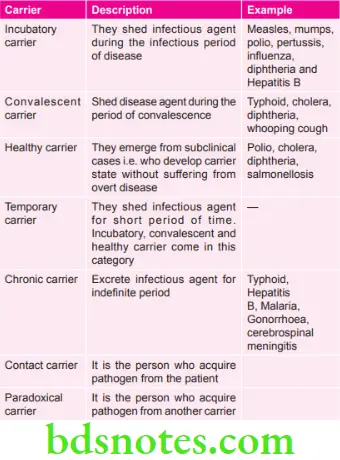
Goals of National Health Policy 2002 which are to be Achieved by 1st August 2011
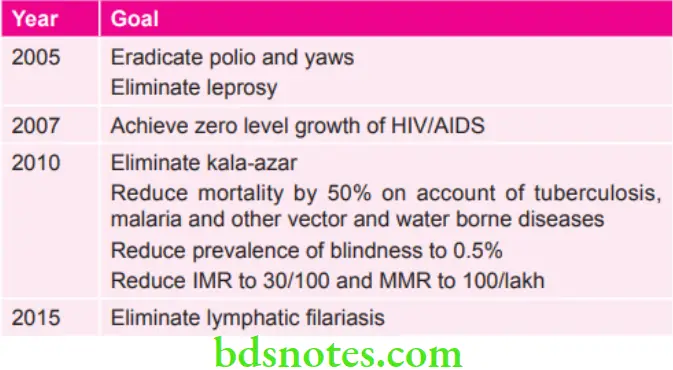
Various Statistical Scales to Measure the Data
Following are the statistical scales to measure the data
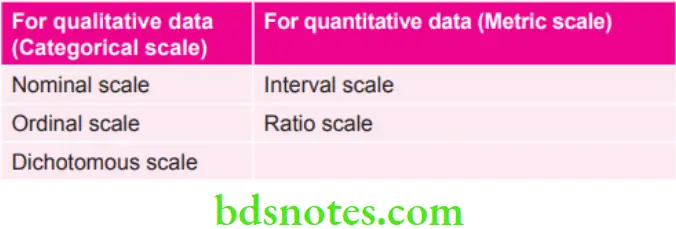
Various scales in Detail with their Examples
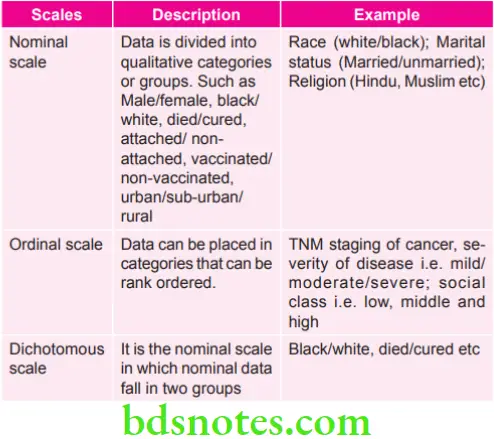
Various Drinking Water Sources
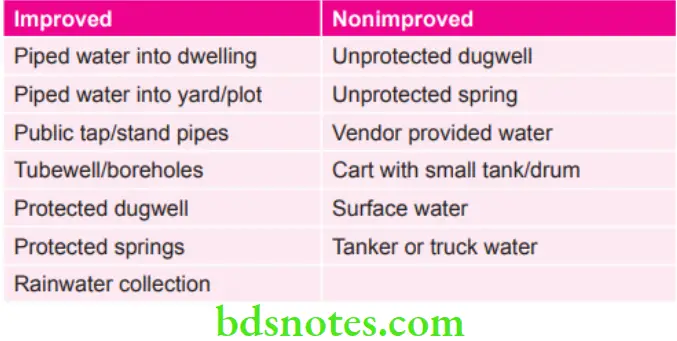
Various Quartiles

Various Bias
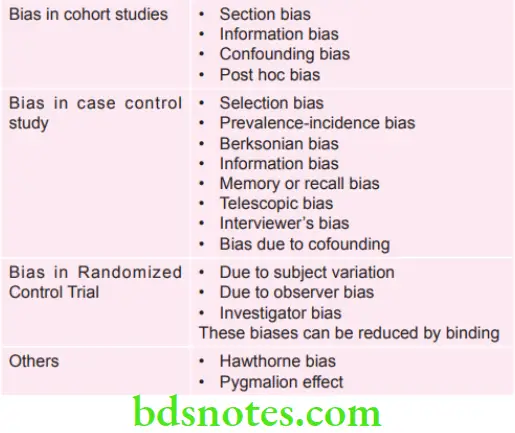
Various categories of waste and color coded bags
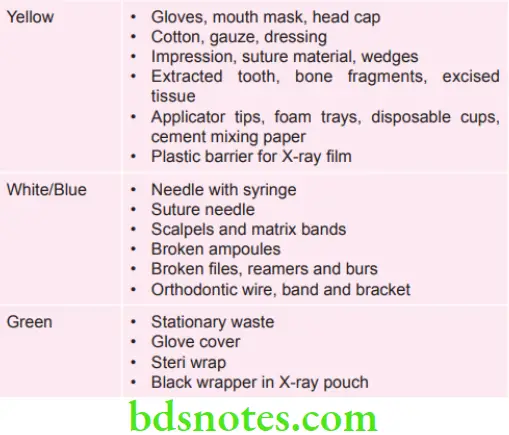
Indian National Immunization Schedule
For pregnant ladies
- TT-1: Early in pregnancy
- TT-2: 4 weeks after TT-1
- TT booster: If received 2 TT doses in a pregnancy within last 3 years
For Infants
- At birth: BCG & OPV
- At 6 weeks: BCG if not given at birth DPT-1, OPV-1 and Hepatitis B-1
- At 10 weeks: DPT-2, OPV-2 and Hepatitis B-2
- At 14 weeks: DPT-3, OPV-3 and Hepatitis B-3
- At 9 months: Measles, Vitamin A (1 lakh IU)
At 16 to 24 months
- Measles-2
- DPV and OPV boosters
- Japanese encephalitis
- Vitamin A (then one dosage every 6 months upto the age of 15 years
At 5 to 6 years
- DPT booster
- Vitamin A
At 10 and 16 years
Tetanus toxoid. Second dose should be given at interval of one month Indian Academy of Pediatrics recommends inclusion of more vaccines in immunization schedule
- Hib conjugate: 6, 10 and 14 weeks
- MMR: 15 months
- Typhoid: 2, 5, 8 and 12 years
Demographic Cycle of a Nation
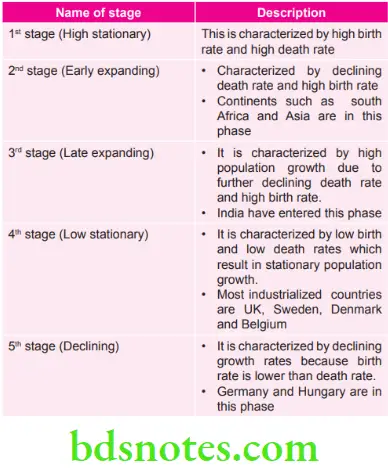
Degrees of Supervision of Auxiliaries by ADA 1975
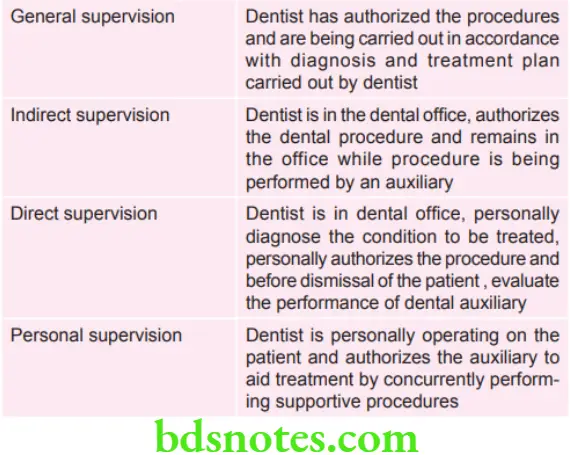
Types of Association
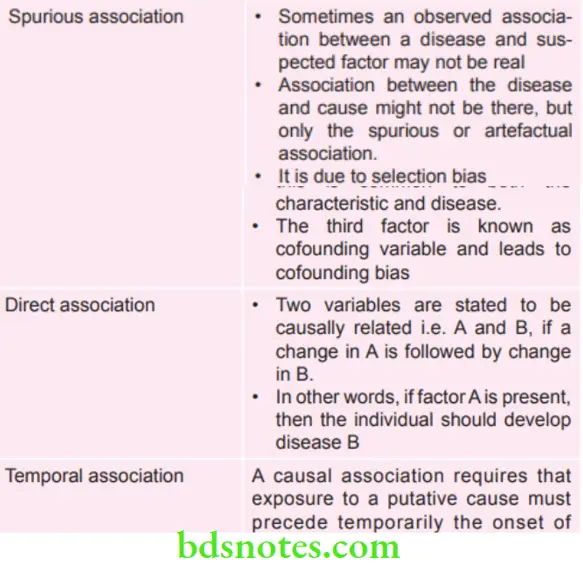
Types of Need for Dental Care
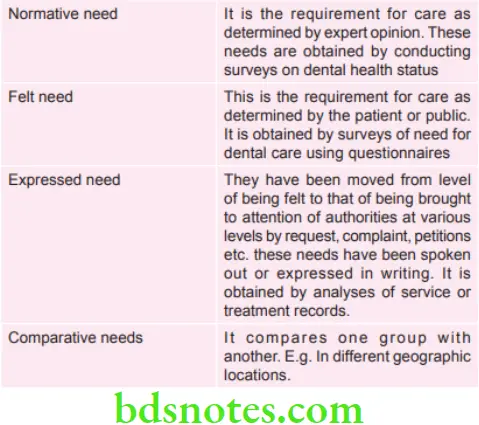
Recommended Dosage Levels of Supplemental Fluoride
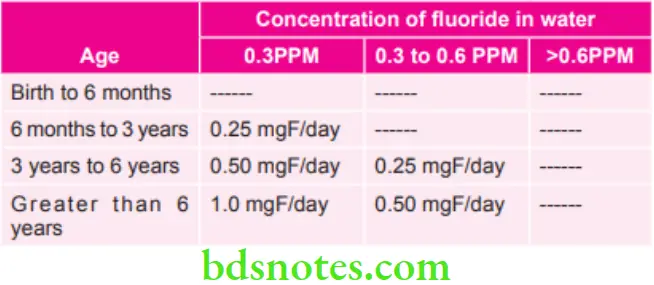

Leave a Reply